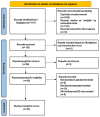Increased Levels of HbA1c in Individuals with Type 2 Diabetes and Depression: A Meta-Analysis of 34 Studies with 68,398 Participants
- PMID: 36009468
- PMCID: PMC9405837
- DOI: 10.3390/biomedicines10081919
Increased Levels of HbA1c in Individuals with Type 2 Diabetes and Depression: A Meta-Analysis of 34 Studies with 68,398 Participants
Abstract
Glycosylated hemoglobin is used to diagnose type 2 diabetes mellitus and assess metabolic control. Depression itself has been associated with high levels of HbA1c in individuals with T2DM. The association between diabetes and depression suggests the usefulness of determining HbA1c as a biological marker of depressive symptoms. The aim of this study was to determine HbA1c levels in individuals with T2DM with vs. without depression. Additionally, we analyzed the influence of pharmacological treatments, time of evolution, and complications of disease. We performed a literature search in different databases published up to January 2020. A total of 34 articles were included. Our results showed that individuals with T2DM with depression showed increased levels of HbA1c in comparison to individuals with T2DM without depression (d = 0.18, 95% CI: 0.12−0.29, p(Z) < 0.001; I2 = 85.00). We also found that HbA1c levels remained elevated in individuals with T2DM with depression who were taking hypoglycemic drugs (d = 0.20 95% CI: 0.11−0.30, p(Z) < 0.001; I2 = 86.80), in individuals with less than 10 years of evolution (d = 0.17 95% CI: 0.09−0.26, p(Z) = 0.001; I2 = 66.03) and in individuals with complications of the disease (d = 0.17, 95% CI: 0.07−0.26, p(Z) < 0.001; I2 = 58.41). Our results show that HbA1c levels in individuals with T2DM with depression are significantly increased compared to controls with T2DM without depression. Additionally, these levels remained elevated in individuals who were taking hypoglycemic drugs, those with less than 10 years of disease evolution, and those with complications related to diabetes. It is necessary to examine the existence of a diabetes−HbA1c−depression connection.
Keywords: HbA1c; complications; depression; diabetes; hypoglycemic drug.
Conflict of interest statement
The authors declare no conflict of interest.
Figures





Similar articles
-
Association Between the Variability of Glycated Hemoglobin and Retinopathy in Patients with Type 2 Diabetes Mellitus: A Meta-Analysis.Horm Metab Res. 2023 Feb;55(2):103-113. doi: 10.1055/a-1931-4400. Epub 2022 Oct 12. Horm Metab Res. 2023. PMID: 36223803
-
Effect of motivational interviewing intervention on HgbA1C and depression in people with type 2 diabetes mellitus (systematic review and meta-analysis).PLoS One. 2020 Oct 23;15(10):e0240839. doi: 10.1371/journal.pone.0240839. eCollection 2020. PLoS One. 2020. PMID: 33095794 Free PMC article.
-
The bidirectional longitudinal association between depressive symptoms and HbA1c : A systematic review and meta-analysis.Diabet Med. 2022 Feb;39(2):e14671. doi: 10.1111/dme.14671. Epub 2021 Sep 5. Diabet Med. 2022. PMID: 34407250 Free PMC article.
-
Clinical course of a cohort with type 2 diabetes mellitus after endocrine assessment. A 26-week study.Endocrinol Diabetes Nutr (Engl Ed). 2018 Apr;65(4):220-228. doi: 10.1016/j.endinu.2017.11.006. Epub 2018 Feb 1. Endocrinol Diabetes Nutr (Engl Ed). 2018. PMID: 29358046 English, Spanish.
-
Effects of Urtica dioica on Metabolic Profiles in Type 2 Diabetes: A Systematic Review and Meta-analysis of Clinical Trials.Mini Rev Med Chem. 2022;22(3):550-563. doi: 10.2174/1389557521666210929143112. Mini Rev Med Chem. 2022. PMID: 34587883
Cited by
-
PHQ-9, CES-D, health insurance data-who is identified with depression? A Population-based study in persons with diabetes.Diabetol Metab Syndr. 2023 Mar 22;15(1):54. doi: 10.1186/s13098-023-01028-7. Diabetol Metab Syndr. 2023. PMID: 36945050 Free PMC article.
-
Effectiveness of continuous glucose monitoring in patient management of Type 2 Diabetes Mellitus: an umbrella review of systematic reviews from 2011 to 2024.Arch Public Health. 2024 Dec 2;82(1):231. doi: 10.1186/s13690-024-01459-2. Arch Public Health. 2024. PMID: 39623499 Free PMC article.
-
Association of depression with glycaemic control in people living with diabetes in low- and middle-income countries: a systematic review and meta-analysis.BMJ Glob Health. 2025 Jul 31;10(7):e018939. doi: 10.1136/bmjgh-2025-018939. BMJ Glob Health. 2025. PMID: 40750117 Free PMC article.
-
Trends in Depression Among Hospitalized Patients with Type 2 Diabetes in Spain (2017-2023): A Population-Based Analysis with a Focus on Sex Differences and In-Hospital Outcomes.J Clin Med. 2025 Jun 1;14(11):3895. doi: 10.3390/jcm14113895. J Clin Med. 2025. PMID: 40507657 Free PMC article.
-
Association between the triglyceride glucose index and depression: a meta-analysis.Front Psychiatry. 2024 Jun 20;15:1390631. doi: 10.3389/fpsyt.2024.1390631. eCollection 2024. Front Psychiatry. 2024. PMID: 38966187 Free PMC article.
References
-
- Attal S., Mahmoud M.H., Aseel M.T., Candra A., Amuna P., Elnagmi M., Abdallah M., Ismail N., Abdelrazek A., Albaw D., et al. Indicators of Quality of Clinical Care for Type 2 Diabetes Patients in Primary Health Care Centers in Qatar: A Retrospective Analysis. Int. J. Endocrinol. 2019;2019:3519093. doi: 10.1155/2019/3519093. - DOI - PMC - PubMed
Publication types
Grants and funding
LinkOut - more resources
Full Text Sources

